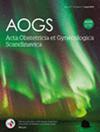Burnout, wellbeing and defensive medical practice in obstetricians and gynecologists in the UK before and after the COVID pandemic: A repeated cross-sectional survey study
Abstract
Introduction
There is evidence that burnout rates in doctors are high following the COVID pandemic, but with considerable variation across geographical location and specialty. In 2018, we performed a UK-wide survey of obstetrics and gynecology (O&G) doctors, providing baseline data on burnout, wellbeing, and defensive medical practice (DMP) directly before the pandemic. This study aims to determine the prevalence of burnout, poor wellbeing, and DMP in obstetricians and gynecologists after the pandemic, to compare these to pre-pandemic levels, and to explore the relationship between burnout, poor wellbeing, and DMP.
Material and Methods
This was a repeated national cross-sectional survey study. Practicing obstetrics and gynecology doctors registered with the Royal College of Obstetricians and Gynaecologists (RCOG) were eligible to participate. In 2022, an email containing a survey link was sent to 7388 UK doctors registered with the RCOG. The same method and measures were used as in our previous 2018 study. Burnout prevalence was assessed using the Maslach Burnout Inventory Human Services Survey for Medical Personnel (MBI). Wellbeing and DMP were assessed using self-report questionnaires.
Results
The response rate for the post-pandemic survey was 19% (1400/7388) and 55% (3102/5661) for the pre-pandemic survey. A total of 1114 out of 1400 (80%) met the inclusion criteria and completed the MBI. Burnout criteria were met in 72%, compared with 36% before the pandemic (adjusted odds ratio [AOR] 4.7, 95% confidence interval [CI] 4.0 to 5.5). Highest levels were seen in trainees (80%). Thirty-nine percent of doctors reported DMP compared with 13% pre-pandemic. Worse doctor wellbeing was reported across all items; 62% of doctors reported anxiety, 31% depression, and 9% suicidal thoughts compared with 33%, 14%, and 3% pre-pandemic. Burnout was associated with DMP and poor wellbeing, including suicidal thoughts, depression, and anxiety.
Conclusions
This national study suggests high levels of burnout in obstetricians and gynecologists compared with pre-pandemic levels, particularly in trainees. There was a probable decline in wellbeing compared with pre-pandemic levels. Poor wellbeing and DMP were associated with burnout. Burnout interventions to improve doctor wellbeing, quality of care, and patient safety are urgently needed.




 求助内容:
求助内容: 应助结果提醒方式:
应助结果提醒方式:


